
[Source:
Nick Catford]
| Date opened: |
18.11.1846 |
| Location: |
On the west side of London Road (A600) |
| Company on opening: |
London & North Western Railway |
| Date closed to passengers: |
14.5.1984 |
| Date closed completely: |
14.5.1984 |
| Company on closing: |
British Rail (London Midland Region) |
| Present state: |
Overgrown platforms are extant. Some 1970s lamp posts are also still in place. |
| County: |
Bedfordshire |
| OS Grid Ref: |
TL052489 |
| Date of visit: |
December 1967, June 1985 & 8 March 2014 |
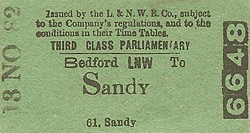 Notes: Bedford became an important trading centre with the opening of the River Ouse Navigation between the Wash and Kempston Mill at Bedford in 1689. An alterative route for waterborne traffic was later provided with the opening of the main line of the Grand Junction Canal in 1800 with goods from Bedford reaching the canal at Newport Pagnell by road. Notes: Bedford became an important trading centre with the opening of the River Ouse Navigation between the Wash and Kempston Mill at Bedford in 1689. An alterative route for waterborne traffic was later provided with the opening of the main line of the Grand Junction Canal in 1800 with goods from Bedford reaching the canal at Newport Pagnell by road.
A number of local businessmen, with the support of the Duke of Bedford, promoted the Bedford Railway as a means of improving the transhipment of goods to and from the town. Within two years of opening, 10,671 tons of coal were unloaded at Bedford. Although the railway built a branch to the Ouse Navigation, river traffic was unable to compete with the railway, especially after the arrival of the Midland Railway's Leicester - Hitchin line in 1857.
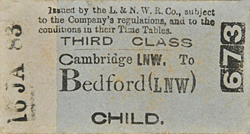 As built, Bedford station was a terminus with a single low platform (later raised) and an overall roof (trainshed). All the buildings were on the south side of the line facing the Swan Inn and the main station building at the west end of the 'London' platform as it was generally known comprised (from west - east): gents' toilets, parcel office, parcel and cloak room, booking office, general waiting room, gents' waiting room, ladies waiting room and toilets. There was a book stall on the platform in front of the gents' waiting room. A canopy at the front of the building provided protection from the weather for passengers arriving by coach or cab. There was a water tank at the east end of the platform. A two road carriage shed was built opposite the platform. As built, Bedford station was a terminus with a single low platform (later raised) and an overall roof (trainshed). All the buildings were on the south side of the line facing the Swan Inn and the main station building at the west end of the 'London' platform as it was generally known comprised (from west - east): gents' toilets, parcel office, parcel and cloak room, booking office, general waiting room, gents' waiting room, ladies waiting room and toilets. There was a book stall on the platform in front of the gents' waiting room. A canopy at the front of the building provided protection from the weather for passengers arriving by coach or cab. There was a water tank at the east end of the platform. A two road carriage shed was built opposite the platform.
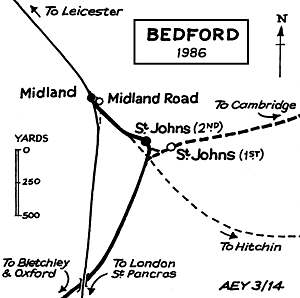 Unusually, the goods facilities were sited away from the passenger station alongside the branch to the River Ouse Navigation. This allowed easy transhipment of goods between river and railway. The yard included two large goods sheds, stables and a 10-ton capacity crane. A short siding serving a cattle dock and pens and Franklin's wagon repair shed was sited at the north end of the yard, at right angles to the other sidings where there were two turnplates. Unusually, the goods facilities were sited away from the passenger station alongside the branch to the River Ouse Navigation. This allowed easy transhipment of goods between river and railway. The yard included two large goods sheds, stables and a 10-ton capacity crane. A short siding serving a cattle dock and pens and Franklin's wagon repair shed was sited at the north end of the yard, at right angles to the other sidings where there were two turnplates.
A second connecting line to the goods yard created a triangle. The Bedford Railway opened an engine shed here on 17 November 1846. The shed was built to accommodate three roads but only ever had two. The engine in use would use one road with a spare engine using the other road. In later years there was usually only one engine with coal wagons using the other road. Diverted drainage created a pond within the triangle which was used as a water supply for the shed and the station.
The Midland Railway's Bedford - Hitchin line crossed the south-west end of the triangle with an unusual flat crossing which opened in March 1875. Almost immediately a Midland passenger train collided with the rear coaches of a Bedford service, killing one passenger and injuring four others. The subsequent enquiry identified a badly-positioned Bedford starter signal as a major cause of the accident. To remedy this, a signal box was opened in 1877 to control new interlocked signals. Block signalling was introduced throughout the Bedford line, when the route was extended to Cambridge.
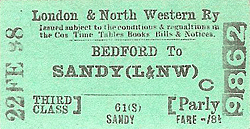 Bedford St Johns No.1 (aka Bedford L&NW Crossing) signal box was of a London & North Western Railway type 5 design fitted with a 5- lever London & North Western Railway Tappet frame. The signal box was renamed Bedford St Johns No.1 by the LMS (possibly on 2 June 1924 when the station was renamed) and was further renamed Bedford St Johns on 25 January 1970 after the closure of Bedford St Johns No.2 signal box. The signal box was damaged by fire in 1977 and was rebuilt with a British Railways London Midland Region type 15 design top. At some time before closure the frame was reduced to 34 levers, closure coming on 23 July 2004 when the Bletchley to Bedford closed for rebuilding, reopening on 6 September 2004 and controlled from Marston Vale Signalling Control Centre at Ridgmont. The box was located on the west side of the Midland line between the two diverging LNWR lines - one line to the station the other to the goods yard. At the north end of the triangle the line to the River Ouse also made a junction with the Midland line just south of their Bedford station. Bedford St Johns No.1 (aka Bedford L&NW Crossing) signal box was of a London & North Western Railway type 5 design fitted with a 5- lever London & North Western Railway Tappet frame. The signal box was renamed Bedford St Johns No.1 by the LMS (possibly on 2 June 1924 when the station was renamed) and was further renamed Bedford St Johns on 25 January 1970 after the closure of Bedford St Johns No.2 signal box. The signal box was damaged by fire in 1977 and was rebuilt with a British Railways London Midland Region type 15 design top. At some time before closure the frame was reduced to 34 levers, closure coming on 23 July 2004 when the Bletchley to Bedford closed for rebuilding, reopening on 6 September 2004 and controlled from Marston Vale Signalling Control Centre at Ridgmont. The box was located on the west side of the Midland line between the two diverging LNWR lines - one line to the station the other to the goods yard. At the north end of the triangle the line to the River Ouse also made a junction with the Midland line just south of their Bedford station.
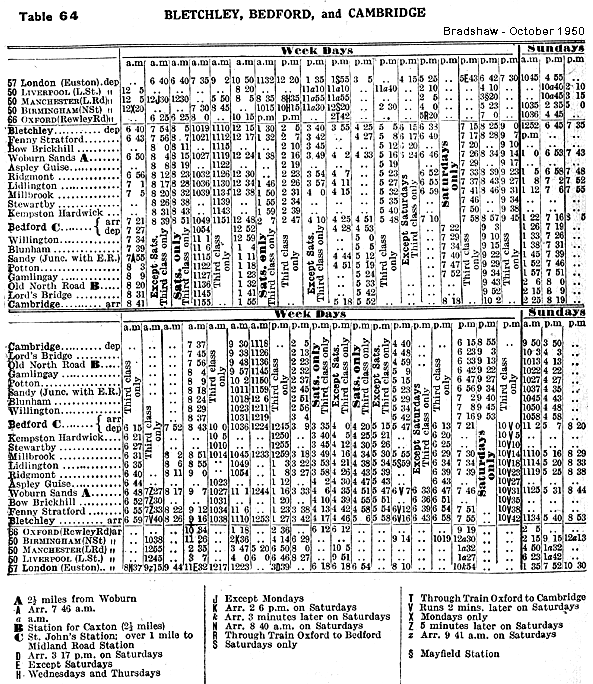
The goods yard had a full range of facilities with Franklin's wagon repair facility established in the yard by 1871. A number of private sidings were also provided; these included Messrs Astell & Sons who operated St Leonards Saw Mills on the Bedford side of the triangle in 1876, whilst Whittaker’s Brewery and sidings opened in 1872 beneath the Ampthill Road bridge, trailing from the original Ouse River branch. Roger’s Siding, into the flour mill site, was added in 1886 which crossed in scissor arrangement over the Astell Siding to run alongside the mill. There were also later private sidings on the up side of the station. Two sidings were laid for Messrs B. Ward & Co, in 1905. A siding ran across the Elstow Road and was gated on each side. The siding on the other side of the London Road bridge was installed for Sterling Foundry Specialities Ltd in 1922.
From an early date excursions were run from the station. In 1851 an excursion to the Great Exhibition in London was at maximum capacity with all 25 carriages full to bursting and a second train was assembled to cater for the huge numbers who wanted to travel to the capital.
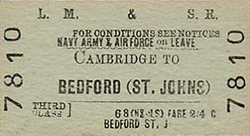 With the arrival of the Midland Railway they made arrangements to use the LNWR station between 8 May 1857 and 1 February 1859 while their own station was being built. Relations between the two railways were, however, never sufficiently good for the provision of a joint station despite a spirited campaign by the Mayor of Bedford in 1861 during the construction of the Cambridge extension. Once the extension opened there were numerous complaints from passengers who had to walk across the town to change trains. With the arrival of the Midland Railway they made arrangements to use the LNWR station between 8 May 1857 and 1 February 1859 while their own station was being built. Relations between the two railways were, however, never sufficiently good for the provision of a joint station despite a spirited campaign by the Mayor of Bedford in 1861 during the construction of the Cambridge extension. Once the extension opened there were numerous complaints from passengers who had to walk across the town to change trains.
To coincide with the opening of the Cambridge line a second platform was provided opposite the original terminus on the site of the carriage shed. Some sources inaccurately refer to this as a re-siting. The new platform had a single-storey range of buildings which became the principal station building. The building was of brick construction with a pitched slate roof with two end gables facing onto the platform. A steeply pitched canopy supported on cast iron columns stretched the length of the building. There was also a wide canopy with a shallower pitch at the front of the building for the benefit of passengers arriving by road vehicles. An LNWR plan of the proposed station building shows the room layout (west to east): external gents' toilet, first class ladies’ waiting room and toilet, first class gents' waiting room, general waiting room in front of the booking office, 2nd class gents' waiting room and another 2nd class gents' waiting room and toilet.
An additional track ran though the station between the platforms; this was often used for the storage of coaches that were not in use. There was a water column and a barrow crossing at the north-east end of the station. Passengers always crossed the line using the barrow crossing; as this involved crossing three tracks a lamp post was provided midway in later years. A short siding serving a cattle dock and pens was sited to the rear of the platform at the east end to supplement livestock facilities already provided in the goods yard.
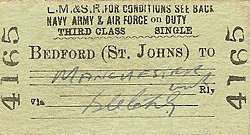 Under the 1923 Grouping, both the Midland and the LNWR came under the control of the LMS. To avoid confusion both Bedford stations were renamed on 2 June 1924. The former LNWR station became Bedford St Johns and the former Midland station became Bedford Midland Road. The engine shed closed on 1 January 1924 and was quickly demolished although the coaling facilities were retained. Under the 1923 Grouping, both the Midland and the LNWR came under the control of the LMS. To avoid confusion both Bedford stations were renamed on 2 June 1924. The former LNWR station became Bedford St Johns and the former Midland station became Bedford Midland Road. The engine shed closed on 1 January 1924 and was quickly demolished although the coaling facilities were retained.
Although the Second World War saw the Oxford-Cambridge line handle unprecedented levels of traffic, it suffered from a lack of investment in the post-war years. The up platform train shed was removed in the 1950s/early 1960s and replaced with a makeshift-looking flat canopy supported on the girders that once supported the trainshed. When the Oxford - Cambridge line was closed from 1 January 1968 the central section between Bletchley and Bedford was retained with trains terminating at Bedford St Johns. The station became unstaffed from 15 July 1968 downgrading Bedford St Johns to the status of a terminus halt under the authority of then area manager at Bedford Midland Road. All the buildings including the water tower were demolished in 1970/71 leaving a remnant of the trainshed in the form of a short canopy supported on girders with a timber back wall on the up platform. The goods yard closed on 10 September 1970 but, according to Clinker, reopened 4 December 1972; no final closure date is recorded - much of the site is now a public car park. The Midland goods yard closed 30 August 1971.
The replacement bus service between Bedford and Cambridge was itself withdrawn in July 1971 as the local authorities along the route withdrew the subsidy paid to the Eastern Counties and United Counties Omnibus Company who provided the service.
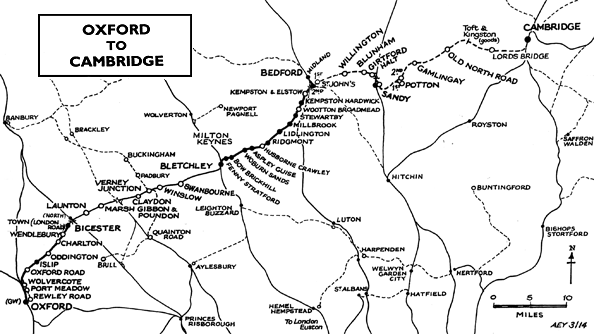
On 14 May 1984 Bedford St. St. Johns closed and was replaced with a new station at the north end of the triangle at entrance to the goods yard. The platform extends under Ampthill Road. This allowed trains to continue into Bedford Midland station (renamed from Bedford Midland Road on 8 May 1978). The new connection runs over the route of the Midland's Hitchin line, which closed in 1964.
Bedford St Johns, in common with others on the Marston Vale Line, is covered by the Marston Vale Community Rail Partnership, which aims to increase use of the line by involving local people. Services are operated by a Class 153 single-car diesel multiple unit and a 2-car Class 150 unit.
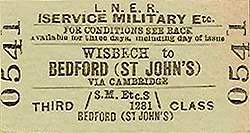 East West Rail, a consortium of local business and local authorities in East Anglia was formed in 1995 to campaign for improved rail connections between East Anglia and central, southern & western England. The have commissioned a number of feasibility studies and one of their proposals is the reopening of the entire Oxford - Cambridge route. East West Rail, a consortium of local business and local authorities in East Anglia was formed in 1995 to campaign for improved rail connections between East Anglia and central, southern & western England. The have commissioned a number of feasibility studies and one of their proposals is the reopening of the entire Oxford - Cambridge route.
In July 2012 the government announced that the line between Oxford and Bletchley would be reopened within an overall investment programme for trains between 2014 and 2019. If the line between Bedford and Cambridge is to be reopened the original Bedford St John station will need to be reopened to maintain the correct alignment at Bedford. After closure in 1984 the station site gradually returned to nature and by the end of the first decade of the twenty-first century all that could be seen was lamp posts sticking up through the undergrowth. In 2013 the site was cleared of some undergrowth. |
BRIEF HISTORY OF THE BEDFORD
RAILWAY
A group of local businessmen first promoted a line to Bedford in 1844. The proposal was supported by engineer George Stephenson. A public meeting was held on 23 April 1844 where there was some discussion about where the line should form a junction with the London & Birmingham. Stephenson was keen that the junction should be at Bletchley and although there was spirited opposition his proposal was eventually accepted.
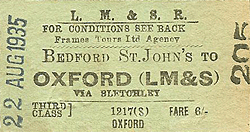 A prospectus for the Bedford & London & Birmingham Railway was drawn up on 28 May 1844, with the engineers being named as George and Robert Stephenson. When complete the line was to be worked by the London & Birmingham Railway; work started on 13 December 1845 and was completed in September 1846. A prospectus for the Bedford & London & Birmingham Railway was drawn up on 28 May 1844, with the engineers being named as George and Robert Stephenson. When complete the line was to be worked by the London & Birmingham Railway; work started on 13 December 1845 and was completed in September 1846.
During the construction of the Bedford line, the London & Birmingham Railway amalgamated with the Grand Junction Railway to form the London & North Western Railway who took over the running of the line.
Intermediate stations from Bletchley were Fenny Stratford, Ridgmont, Lidlington and Manston (later renamed Millbrook). The line opened on 18 November 1846; the line from Oxford - Bletchley opened on 20 May 1851. The final link from Bedford to Cambridge opened on 7 July 1862 provided an important cross-country line between Oxford and Cambridge, forming one of the few east-west routes with the capability of reaching the east coast ports. Most services, however, ran from Oxford to Bletchley and from Bletchley to Cambridge.
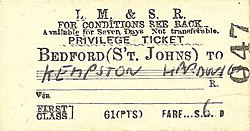 A rail-motor service between Bletchley and Belford was introduced on 1 December 1905. Seven new stations were opened at Bow Brickhill, Aspley Guise, Husborne Crawley, Wootton Pillinge, Wootton Broadmead, Kempston Hardwick and Kempston & Elstow. An eighth one called Brickyard Halt is shown in company records near Wootton Pillinge but this never appeared in a public timetable. Whereas the Great Western Railway named such additional unstaffed stations ‘halts’ the London & North Western Railway referred to them as ‘motor’ or ‘rail-motor’ stations, and subsequently there has been uncertainty about whether Bow Brickhill and the others should be called ‘halts’. The Ordnance Survey practice for the Bedford Railway motor stations was to identify them as halts until the London Midland Region ceased to use this suffix in 1968. A rail-motor service between Bletchley and Belford was introduced on 1 December 1905. Seven new stations were opened at Bow Brickhill, Aspley Guise, Husborne Crawley, Wootton Pillinge, Wootton Broadmead, Kempston Hardwick and Kempston & Elstow. An eighth one called Brickyard Halt is shown in company records near Wootton Pillinge but this never appeared in a public timetable. Whereas the Great Western Railway named such additional unstaffed stations ‘halts’ the London & North Western Railway referred to them as ‘motor’ or ‘rail-motor’ stations, and subsequently there has been uncertainty about whether Bow Brickhill and the others should be called ‘halts’. The Ordnance Survey practice for the Bedford Railway motor stations was to identify them as halts until the London Midland Region ceased to use this suffix in 1968.
The rail-motors were superseded by pull-and-push units which continued in operation until the introduction of DMUs in 1959.
The Second World War intensified traffic on the line as never before. With the return of peace and the nationalisation of the run-down railway network the newly formed British Railways Board was looking to close unprofitable lines.
In 1955 the Railway Modernisation Plan proposed improvements to cross-country facilities between Oxford and Cambridge with the aim of maintaining a link between the major main line railways outside the congested Greater London area thereby allowing freight traffic to be transferred between three railway regions and easing the burden on London marshalling yards. Within a few years the policy changed and the line was not upgraded with the Bletchley flyover remaining as a monument to the fruitless proposal.
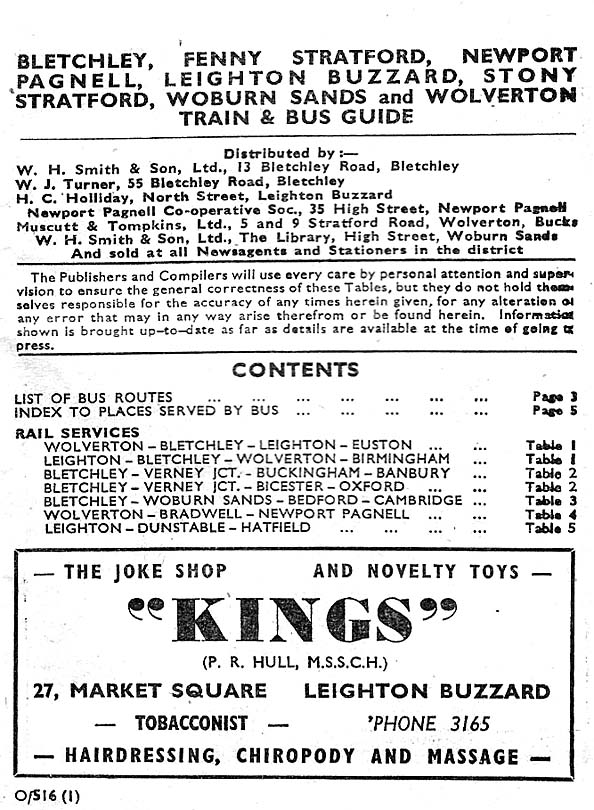
An attempt was made to close the Oxford - Bletchley - Cambridge line in 1959 but local pressure succeeded in winning a reprieve. There was some relief when Dr Beeching did not include the cross country Oxford to Cambridge line in his closure proposals in 1963, but just one year later the British Railways Board published closure plans for the whole route. The introduction of new diesel trains in the 1960s allowed British Railways to run much faster trains, and the need for a cross country service declined as passengers found it quicker to travel between Oxford and Cambridge via London. The lines between Oxford and Bletchley and Bedford and Cambridge closed after the last day of service on 30 December 1967; the section between Bletchley and Bedford remained open, although downgraded.
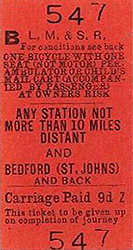 All of the stations lost their goods and parcels facilities, and every station except Bletchley became an unstaffed halt from 15 July 1968. Closure was once again proposed, and it was announced that the remaining section of the Oxford - Cambridge route would close in October 1972. There were numerous objections to the closure which was postponed until a suitable replacement bus service could be introduced. Once this was in place closure was announced for 31 December 1972. All of the stations lost their goods and parcels facilities, and every station except Bletchley became an unstaffed halt from 15 July 1968. Closure was once again proposed, and it was announced that the remaining section of the Oxford - Cambridge route would close in October 1972. There were numerous objections to the closure which was postponed until a suitable replacement bus service could be introduced. Once this was in place closure was announced for 31 December 1972.
The Bedford Rail Users' Association was formed to fight the closure, and the opposition was so strong that British Rail was forced to postpone once again, pending an appeal by local groups. At this time government thinking on rail closures was changing and a grant was provided to maintain the service. With the development of the large new town of Milton Keynes, which incorporated Bletchley, the line began attracting new customers.
In 1973 a 20-year contract between the Greater London Council and the London Brick Company assured the line’s future. The contract was worth £10m to British Rail who began operating block trains between new sidings at Stewartby and a new handling depot at Hendon.
For much of the twentieth century this 16-mile line had a particularly distinctive character, its closely-spaced stations being either in the Gothic Revival style or diminutive halts. The numerous staffed level crossings also gave the line a certain charm; even in the mid 1980s the passenger would be aware of gate-keepers standing at each crossing as their train passed. The landscape was also distinctive between Bedford and Ridgmont as the route was hemmed in by forests of tall chimneys and massive clay pits. Nowhere was this more the case than at Stewartby. From 1968 until its replacement in 1984 on a new route into Bedford (Midland) the Bedford – Bletchley line had its eastern terminus at Bedford St Johns, an unstaffed ‘halt’ an inconvenient distance from the main line station.
The service is now operated by Marston Vale Community Rail Partnership part of London Midland who operate services on the West Coast Main Line from London Euston previously run by Silverlink and in the West Midlands previously run by Central Trains. The franchise was originally due to expire in September 2015 but in March 2013 was extended until June 2017.
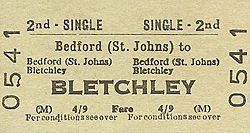 The Bedford - Bletchley (Marston Vale) Line is one of the two remaining sections of the former Varsity Line (Oxford - Cambridge) still in passenger use. In the 2011 Autumn Statement the Chancellor of the Exchequer, George Osborne, announced the allocation of £270 million for the East West Rail Consortium to reinstate the Oxford – Bletchley – Bedford section of the Varsity Line. The service will link the Marston Vale Line (calling at Bedford, Lidlington, Woburn Sands and Bletchley only) to Winslow, Bicester Town, Oxford and Reading. The Consortium hopes later to reopen the Bedford — Cambridge section, for which a new route may be required, possibly involving the use of the East Coast main line south from Sandy then the Hitchin – Cambridge line, with a new north-to-east chord just north of Hitchin. The Bedford - Bletchley (Marston Vale) Line is one of the two remaining sections of the former Varsity Line (Oxford - Cambridge) still in passenger use. In the 2011 Autumn Statement the Chancellor of the Exchequer, George Osborne, announced the allocation of £270 million for the East West Rail Consortium to reinstate the Oxford – Bletchley – Bedford section of the Varsity Line. The service will link the Marston Vale Line (calling at Bedford, Lidlington, Woburn Sands and Bletchley only) to Winslow, Bicester Town, Oxford and Reading. The Consortium hopes later to reopen the Bedford — Cambridge section, for which a new route may be required, possibly involving the use of the East Coast main line south from Sandy then the Hitchin – Cambridge line, with a new north-to-east chord just north of Hitchin.
On 16 July 2012 the Coalition Government announced that the Marston Vale route would be electrified, as will the currently disused line from Bletchley to Oxford. This would form part of a wider 'Electric Spine' stretching from Yorkshire and the West Midlands to Southampton and South Coast Ports.
Tickets from Michael Stewart. Bradshaw from Nick Catford. Route map drawn by Alan Young
Sources:
To see other stations on the Bedford Railway between Bletchley and Bedford (The Marston Vale Line) click on the station name:
Fenny Stratford, Bow Brickhill, Woburn Sands, Aspley Guise, Husborne Crawley (Closed), Ridgmont, Lidlington, Millbrook, Stewartby, Wooton Broadmead (Closed), Kempston Hardwick & Kempston & Elstow
To see the other stations
on the Oxford - Cambridge line click on the station name: Oxford
Rewley Road, Port
Meadow Halt, Wolvercote
Halt, Oxford
Road Halt, Islip,
Oddington Halt,
Charlton
Halt, Wendlebury
Halt, Bicester
London Road, Launton,
Marsh
Gibbon & Poundon, Claydon,
Verney
Junction, Winslow,
Swanbourne,
Willington,
Blunham, Girtford
Halt, Sandy,
Potton, Gamlingay,
Old North Road
& Lords
Bridge - see also The Bedford
Railway (stations still open)
Bedford St Johns Station Gallery 1 1879 - Early 1960s
Bedford station looking south west c.1879. The original platform under the trainshed is seen on the left with the second platform which opened with the Cambridge extension on the right. Note the wide canopy to provide protection from the weather for passengers arriving by coach. The large three-road engine shed is seen in the background. Although built to accommodate three roads it only ever had two. It was closed by the LMS shortly after the Grouping. A Francis Trevithick/Alexander Allan 6ft 2-2-2- Single rebuilt by Francis Webb waits to depart with a Cambridge train. An early slotted semaphore signal post is seen with the signalman's hut immediately behind it.
Copyright photo from John Alsop collection
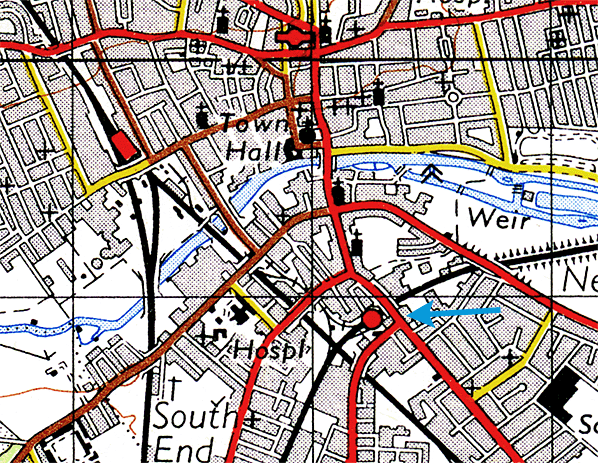
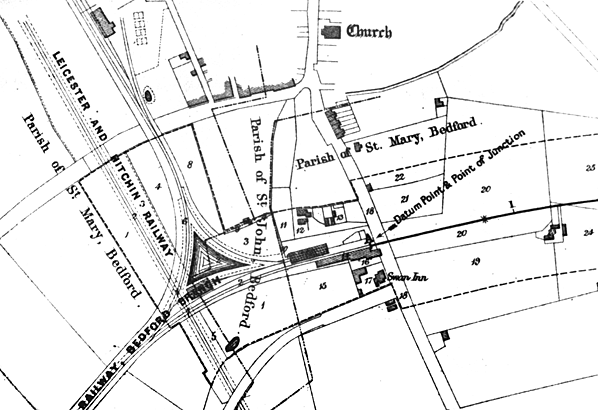
Engineering plan for the Cambridge extension showing the layout of Bedford station in 1860. The original terminus is shown on the north side of the line opposite the Swan Inn. Although the single platform handled traffic in both directions it was always referred to as the 'London platform'. A carriage shed is shown opposite the platform; this was demolished to make way for the second platform.
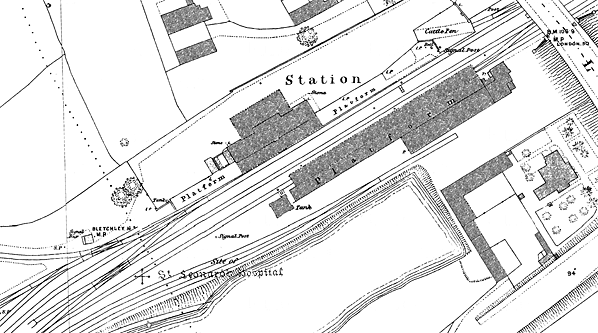
1884 1:500 OS Town Plan shows the layout of the station after the opening of the Cambridge extension and the second platform. The original trainshed is seen to the south of the line with the station buildings at the east end. There is a water tank on a brick base at the west end of the platform; this was fed from the lake which was created in the triangle as a source of water for the station. The Cambridge platform is seen on the north side; this had a canopy over the platform stretching the length of the building and another canopy over the forecourt for the benefit of passengers arriving by coach in wet weather. The original building also had a canopy over the forecourt but as it is not shown on this map it is assumed to have been removed by this date. Although there were substantial livestock facilities at the goods yard, an additional dock and cattle pens were provided at the west end of the new down platform. Click here for a larger version.
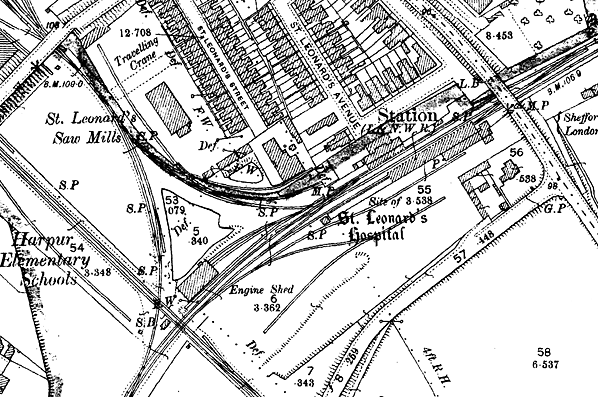
1901 1:2,500 OS map. The triangular junction to the west of Bedford St Johns station allowed quick access to the goods yard from either direction. It was also the link with the Midland Railway whose Bedford - Hitchin line is seen crossing the west side of the triangle. The two road engine shed is seen to the east of the Midland line and in the centre of the triangle is the artificial pond created to provide a water supply for the station. Although the main part of the goods yard is off the map at the top there are private sidings on two sides of the triangle. Those to the south served the works of B. Ward & Co, and those to the east served St Leonard's saw mills. Bedford No.1 signal box is within a smaller triangle to the west of the Midland line.
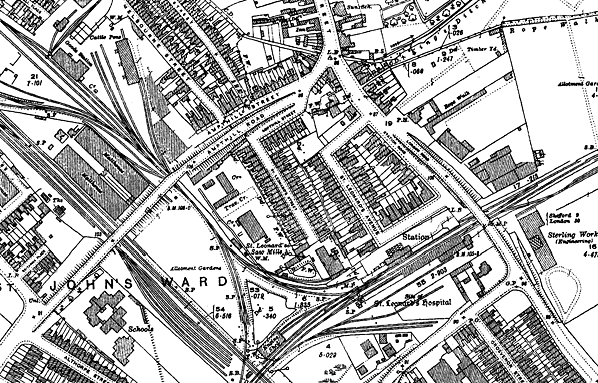
1926 1:2,500 OS shows the layout of Bedford St Johns station and goods yard. The yard was built alongside the branch to the River Ouse Navigation; this is seen running off the edge of the map on the left. The yard had a range of facilities including two large goods sheds. The original shed is seen on the east side of the River Ouse branch with the yard 10-ton capacity crane on the south side of the shed. The second shed and the siding running diagonally across the yard came later. To the north of the first goods shed there is a siding at right angles requiring the use of turnplates so that individual wagons could be turned and pushed into the siding. This served Franklin's wagon repair shed and the cattle dock and pens. The entrance to the yard in Melbourne Street with a weighbridge (WM) is shown inside the entrance. The building to the east of the weighbridge is a stable. Numerous private sidings are seen. Immediately north of the triangle a siding ran into St Leonards saw mill. To the west of the River Ouse branch sidings served the malthouses of Whittaker’s Brewery. To the east of Bedford station a siding ran into the Stirling engineering works. On the west side of the station further sidings ran behind the up platform, the two southernmost serving the works of B. Ward & Co. Click here for a larger
version of this map,
sj_old23.jpg)
Bedford St Johns station looking north-east along the down platform in April 1914. A rake of goods wagons is seen in the 'London' platform beneath the trainshed. Until 2 August 1861 this was the only platform when Bedford was the terminus of the line from Oxford. With the opening if the second platform the principal entrance to the station switched sides. Bedford No.1 signal box on the west side of the triangular junction can just be made out under the bridge.
Copyright photo from John Alsop collection
sj_old9.jpg) Triangular junction in 1914. Bedford (St Johns) station is to the left and Bedford (Midland) is behind the photographer. The LNWR engine shed is seen behind the locomotive. St Leonards saw mills are on the left. The pond can just be made out to the right of the goods train which is heading towards Bletchley.
Triangular junction in 1914. Bedford (St Johns) station is to the left and Bedford (Midland) is behind the photographer. The LNWR engine shed is seen behind the locomotive. St Leonards saw mills are on the left. The pond can just be made out to the right of the goods train which is heading towards Bletchley.
Copyright photo from John Alsop collection
sj_old64.jpg) Aerial view of Bedford St Johns station in 1929. The original timber station building and trainshed is seen at the bottom with the 1861 is seen on the north side of the line. An auto train has just pulled out of the down platform and is passing the cattle dock and pens. Note the wide canopy stretching out over the station forecourt. This was provided for the benefit of passengers arriving by coach or cab in wet weather. W.H. & J. Rogers flour mill is seen top left; this was served by two private sidings.
Aerial view of Bedford St Johns station in 1929. The original timber station building and trainshed is seen at the bottom with the 1861 is seen on the north side of the line. An auto train has just pulled out of the down platform and is passing the cattle dock and pens. Note the wide canopy stretching out over the station forecourt. This was provided for the benefit of passengers arriving by coach or cab in wet weather. W.H. & J. Rogers flour mill is seen top left; this was served by two private sidings.
Reproduced with the kind permission of Simmons Aerofilms Ltd
sj_old58.jpg)
In 1937 the LMS designed a three-car articulated railcar with a single prototype being built at the Derby Carriage and Wagon Works in 1938. The streamlined three-car train was a single articulated unit. The articulation was an idea that had already been developed by Sir William Stanier for some locomotive-hauled stock. Mechanically the train was a development of the railcars that had entered service from 1933 on the LMS Northern Counties Committee's lines in Northern Ireland. It was first used on the Oxford-Cambridge line on 12 September 1938 where the large number of stations in quick succession required rapid acceleration between them. There were three daily special runs between Cambridge and Oxford with two in the opposite direction, and some shorter trips between Bletchley and Cambridge. These were in addition to the normal timetabled services and were advertised by handbill. The journey time for the 77 miles between Oxford and Cambridge was 1¾ hours compared with three hours taken by steam trains. The unit was withdrawn at the outbreak of WW2 and never re-entered passenger service, being converted into a two-car maintenance unit after the war. It is seen in the down platform at Bedford St Johns station in April 1938.
Photo
from Jim Lake collection
sj_old69.jpg)
Another view of the three-car articulated railcar at Bedford St Johns station c1939.
Photo from Ian McDonald collection (Les Pateman Collection)'
sj_old33.jpg)
With just two years service left, 1295 is seen in the down platform at Bedford St. Johns station in March 1949 after propelling the 2.05pm service from Bletchley. This is a Johnson-designed 0-4-4T which was built at Derby works and entered Midland Railway service during February 1883. It carried its original number until July 1949, when it was renumbered by BR to 58045 which it carried until withdrawal from Skipton shed during October 1951. In the centre road is 42590, a Stanier-designed 2-6-4 passenger tank which was built for the LMS and entered service on 19 October 1936. Built by the North British Loco Co in Glasgow and classified 4P, it had a service life of over 28 years when it was withdrawn on 27 July 1965 and quickly scrapped.
Copyright photo by HC Casserley
sj_old63.jpg)
Looking north-east from the end of the 'London' platform, beneath the trainshed as a Standard Class 4MT 2-6-4T approaching with a class B stopping passenger train from Cambridge in May 1956. 80083 was designed by R.A.Riddles; it entered service at Bletchley shed on 3 May 1954 and had a working life of only 12 years when it was withdrawn from 71A, Eastleigh shed on 7 August 1966 to be scrapped at Cohens of Morriston during the following January. Note the sign at the end of the platform; the only means of crossing from one platform to the other was by using the barrow crossing at the north-east end of the station. This remained in use until closure of the station in 1984.
Photo
by D J Norton from Photo by DJ Norton - Birmingham web site
A pair of Metropolitan Cammell lightweight diesel multiple units, E79278+79051 leading, being trialled on the Oxford to Cambridge line at Bedford St Johns on 12 May 1957. In 1955, Metropolitan Cammell produced its first lightweight Diesel multiple units, the prototypes of what were to become British Rail's most successful and longest-lived First Generation DMU type, the Class 101. The Class 101 DMUs were built by Metro-Cammell at Washwood Heath in Birmingham from 1956 to 1959. The final five units were withdrawn on 24 December 2003. The oldest set was, by then, just over 47 years old.
Photo
from the Kevin Lane collection from his Flickr photostream
sj_old32.jpg)
Looking north-east along the down platform at Bedford St Johns station c early 1960s, shortly after the trainshed over the 'London' platform was removed. The supporting metal girders and rear wall were retained to support a new flat canopy. It is common practice throughout the railway network for the ladies' toilet to be incorporated into the ladies' waiting room within station buildings while the gents' get an external block at the end of the building as seen here. A bicycle shed is seen next to the gents'.
photo from John Mann collection
Click here for Bedford St Johns Station Gallery 2
June 1962 - May 1970
 Home Page Home Page
| Last
updated: Sunday, 04-Jun-2017 09:34:46 CEST |
© 1998-2014 Disused Stations
| |


sj_old16.jpg)





sj_old23.jpg)
sj_old9.jpg)
sj_old64.jpg)
sj_old58.jpg)
sj_old69.jpg)
sj_old33.jpg)
sj_old63.jpg)
sj_old34.jpg)
sj_old32.jpg)
 Home Page
Home Page  Notes: Bedford became an important trading centre with the opening of the River Ouse Navigation between the Wash and Kempston Mill at Bedford in 1689. An alterative route for waterborne traffic was later provided with the opening of the main line of the Grand Junction Canal in 1800 with goods from Bedford reaching the canal at Newport Pagnell by road.
Notes: Bedford became an important trading centre with the opening of the River Ouse Navigation between the Wash and Kempston Mill at Bedford in 1689. An alterative route for waterborne traffic was later provided with the opening of the main line of the Grand Junction Canal in 1800 with goods from Bedford reaching the canal at Newport Pagnell by road. As built, Bedford station was a terminus with a single low platform (later raised) and an overall roof (trainshed). All the buildings were on the south side of the line facing the Swan Inn and the main station building at the west end of the 'London' platform as it was generally known comprised (from west - east): gents' toilets, parcel office, parcel and cloak room, booking office, general waiting room, gents' waiting room, ladies waiting room and toilets. There was a book stall on the platform in front of the gents' waiting room. A canopy at the front of the building provided protection from the weather for passengers arriving by coach or cab. There was a water tank at the east end of the platform. A two road carriage shed was built opposite the platform.
As built, Bedford station was a terminus with a single low platform (later raised) and an overall roof (trainshed). All the buildings were on the south side of the line facing the Swan Inn and the main station building at the west end of the 'London' platform as it was generally known comprised (from west - east): gents' toilets, parcel office, parcel and cloak room, booking office, general waiting room, gents' waiting room, ladies waiting room and toilets. There was a book stall on the platform in front of the gents' waiting room. A canopy at the front of the building provided protection from the weather for passengers arriving by coach or cab. There was a water tank at the east end of the platform. A two road carriage shed was built opposite the platform.  Unusually, the goods facilities were sited away from the passenger station alongside the branch to the River Ouse Navigation. This allowed easy transhipment of goods between river and railway. The yard included two large goods sheds, stables and a 10-ton capacity crane. A short siding serving a cattle dock and pens and Franklin's wagon repair shed was sited at the north end of the yard, at right angles to the other sidings where there were two turnplates.
Unusually, the goods facilities were sited away from the passenger station alongside the branch to the River Ouse Navigation. This allowed easy transhipment of goods between river and railway. The yard included two large goods sheds, stables and a 10-ton capacity crane. A short siding serving a cattle dock and pens and Franklin's wagon repair shed was sited at the north end of the yard, at right angles to the other sidings where there were two turnplates.  Bedford St Johns No.1 (aka Bedford L&NW Crossing) signal box was of a London & North Western Railway type 5 design fitted with a 5- lever London & North Western Railway Tappet frame. The signal box was renamed Bedford St Johns No.1 by the LMS (possibly on 2 June 1924 when the station was renamed) and was further renamed Bedford St Johns on 25 January 1970 after the closure of Bedford St Johns No.2 signal box. The signal box was damaged by fire in 1977 and was rebuilt with a British Railways London Midland Region type 15 design top. At some time before closure the frame was reduced to 34 levers, closure coming on 23 July 2004 when the Bletchley to Bedford closed for rebuilding, reopening on 6 September 2004 and controlled from Marston Vale Signalling Control Centre at Ridgmont. The box was located on the west side of the Midland line between the two diverging LNWR lines - one line to the station the other to the goods yard. At the north end of the triangle the line to the River Ouse also made a junction with the Midland line just south of their Bedford station.
Bedford St Johns No.1 (aka Bedford L&NW Crossing) signal box was of a London & North Western Railway type 5 design fitted with a 5- lever London & North Western Railway Tappet frame. The signal box was renamed Bedford St Johns No.1 by the LMS (possibly on 2 June 1924 when the station was renamed) and was further renamed Bedford St Johns on 25 January 1970 after the closure of Bedford St Johns No.2 signal box. The signal box was damaged by fire in 1977 and was rebuilt with a British Railways London Midland Region type 15 design top. At some time before closure the frame was reduced to 34 levers, closure coming on 23 July 2004 when the Bletchley to Bedford closed for rebuilding, reopening on 6 September 2004 and controlled from Marston Vale Signalling Control Centre at Ridgmont. The box was located on the west side of the Midland line between the two diverging LNWR lines - one line to the station the other to the goods yard. At the north end of the triangle the line to the River Ouse also made a junction with the Midland line just south of their Bedford station. 
 With the arrival of the Midland Railway they made arrangements to use the LNWR station between 8 May 1857 and 1 February 1859 while their own station was being built. Relations between the two railways were, however, never sufficiently good for the provision of a joint station despite a spirited campaign by the Mayor of Bedford in 1861 during the construction of the Cambridge extension. Once the extension opened there were numerous complaints from passengers who had to walk across the town to change trains.
With the arrival of the Midland Railway they made arrangements to use the LNWR station between 8 May 1857 and 1 February 1859 while their own station was being built. Relations between the two railways were, however, never sufficiently good for the provision of a joint station despite a spirited campaign by the Mayor of Bedford in 1861 during the construction of the Cambridge extension. Once the extension opened there were numerous complaints from passengers who had to walk across the town to change trains.  Under the 1923 Grouping, both the Midland and the LNWR came under the control of the LMS. To avoid confusion both Bedford stations were renamed on 2 June 1924. The former LNWR station became Bedford St Johns and the former Midland station became Bedford Midland Road. The engine shed closed on 1 January 1924 and was quickly demolished although the coaling facilities were retained.
Under the 1923 Grouping, both the Midland and the LNWR came under the control of the LMS. To avoid confusion both Bedford stations were renamed on 2 June 1924. The former LNWR station became Bedford St Johns and the former Midland station became Bedford Midland Road. The engine shed closed on 1 January 1924 and was quickly demolished although the coaling facilities were retained.
 East West Rail, a consortium of local business and local authorities in East Anglia was formed in 1995 to campaign for improved rail connections between East Anglia and central, southern & western England. The have commissioned a number of feasibility studies and one of their proposals is the reopening of the entire Oxford - Cambridge route.
East West Rail, a consortium of local business and local authorities in East Anglia was formed in 1995 to campaign for improved rail connections between East Anglia and central, southern & western England. The have commissioned a number of feasibility studies and one of their proposals is the reopening of the entire Oxford - Cambridge route. A prospectus for the Bedford & London & Birmingham Railway was drawn up on 28 May 1844, with the engineers being named as George and Robert Stephenson. When complete the line was to be worked by the London & Birmingham Railway; work started on 13 December 1845 and was completed in September 1846.
A prospectus for the Bedford & London & Birmingham Railway was drawn up on 28 May 1844, with the engineers being named as George and Robert Stephenson. When complete the line was to be worked by the London & Birmingham Railway; work started on 13 December 1845 and was completed in September 1846. A rail-motor service between Bletchley and Belford was introduced on 1 December 1905. Seven new stations were opened at Bow Brickhill, Aspley Guise, Husborne Crawley, Wootton Pillinge, Wootton Broadmead, Kempston Hardwick and Kempston & Elstow. An eighth one called Brickyard Halt is shown in company records near Wootton Pillinge but this never appeared in a public timetable. Whereas the Great Western Railway named such additional unstaffed stations ‘halts’ the London & North Western Railway referred to them as ‘motor’ or ‘rail-motor’ stations, and subsequently there has been uncertainty about whether Bow Brickhill and the others should be called ‘halts’. The Ordnance Survey practice for the Bedford Railway motor stations was to identify them as halts until the London Midland Region ceased to use this suffix in 1968.
A rail-motor service between Bletchley and Belford was introduced on 1 December 1905. Seven new stations were opened at Bow Brickhill, Aspley Guise, Husborne Crawley, Wootton Pillinge, Wootton Broadmead, Kempston Hardwick and Kempston & Elstow. An eighth one called Brickyard Halt is shown in company records near Wootton Pillinge but this never appeared in a public timetable. Whereas the Great Western Railway named such additional unstaffed stations ‘halts’ the London & North Western Railway referred to them as ‘motor’ or ‘rail-motor’ stations, and subsequently there has been uncertainty about whether Bow Brickhill and the others should be called ‘halts’. The Ordnance Survey practice for the Bedford Railway motor stations was to identify them as halts until the London Midland Region ceased to use this suffix in 1968.
 All of the stations lost their goods and parcels facilities, and every station except Bletchley became an unstaffed halt from 15 July 1968. Closure was once again proposed, and it was announced that the remaining section of the Oxford - Cambridge route would close in October 1972. There were numerous objections to the closure which was postponed until a suitable replacement bus service could be introduced. Once this was in place closure was announced for 31 December 1972.
All of the stations lost their goods and parcels facilities, and every station except Bletchley became an unstaffed halt from 15 July 1968. Closure was once again proposed, and it was announced that the remaining section of the Oxford - Cambridge route would close in October 1972. There were numerous objections to the closure which was postponed until a suitable replacement bus service could be introduced. Once this was in place closure was announced for 31 December 1972. The Bedford - Bletchley (Marston Vale) Line is one of the two remaining sections of the former Varsity Line (Oxford - Cambridge) still in passenger use. In the 2011 Autumn Statement the Chancellor of the Exchequer, George Osborne, announced the allocation of £270 million for the East West Rail Consortium to reinstate the Oxford – Bletchley – Bedford section of the Varsity Line. The service will link the Marston Vale Line (calling at Bedford, Lidlington, Woburn Sands and Bletchley only) to Winslow, Bicester Town, Oxford and Reading. The Consortium hopes later to reopen the Bedford — Cambridge section, for which a new route may be required, possibly involving the use of the East Coast main line south from Sandy then the Hitchin – Cambridge line, with a new north-to-east chord just north of Hitchin.
The Bedford - Bletchley (Marston Vale) Line is one of the two remaining sections of the former Varsity Line (Oxford - Cambridge) still in passenger use. In the 2011 Autumn Statement the Chancellor of the Exchequer, George Osborne, announced the allocation of £270 million for the East West Rail Consortium to reinstate the Oxford – Bletchley – Bedford section of the Varsity Line. The service will link the Marston Vale Line (calling at Bedford, Lidlington, Woburn Sands and Bletchley only) to Winslow, Bicester Town, Oxford and Reading. The Consortium hopes later to reopen the Bedford — Cambridge section, for which a new route may be required, possibly involving the use of the East Coast main line south from Sandy then the Hitchin – Cambridge line, with a new north-to-east chord just north of Hitchin.